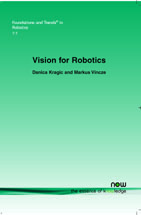Vision for Robotics
By Danica Kragic, Centre for Autonomous Systems, Computational Vision and Active Perception Lab, School of Computer Science and Communication, KTH, Sweden, dani@kth.se | Markus Vincze, Vision for Robotics Lab, Automation and Control Institute, Technische Universitat Wien, Austria, vincze@acin.tuwien.ac.at
Abstract
Robot vision refers to the capability of a robot to visually perceive the environment and use this information for execution of various tasks. Visual feedback has been used extensively for robot navigation and obstacle avoidance. In the recent years, there are also examples that include interaction with people and manipulation of objects. In this paper, we review some of the work that goes beyond of using artificial landmarks and fiducial markers for the purpose of implementing visionbased control in robots. We discuss different application areas, both from the systems perspective and individual problems such as object tracking and recognition.
Vision for Robotics
Robot vision refers to the capability of a robot to visually perceive the environment and use this information to execute different tasks. Visual feedback has been used extensively for robot navigation and obstacle avoidance. In recent years, there have also been examples that include interaction with people and manipulation of objects. Vision in Robotics reviews aspects of robot vision from its early beginnings to the most recent research. It focuses primarily on some of the work that goes beyond the use of artificial landmarks and fiducial markers for the purpose of implementing vision-based control in robots. It discusses various application areas, both from the systems perspective and individual problems such as object tracking and recognition. Vision in Robotics is an ideal and current reference for researchers and professionals working in the fields of machine vision, image processing, and pattern recognition. Its extensive bibliography serves as an invaluable guide to current research.
